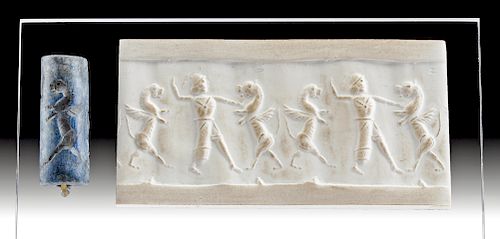Achaemenid Lapis Lazuli Stamp Seal Bead
Lot 73
About Seller
Artemis Gallery
686 S Taylor Ave, Ste 106
Louisville, CO 80027
United States
Selling antiquities, ancient and ethnographic art online since 1993, Artemis Gallery specializes in Classical Antiquities (Egyptian, Greek, Roman, Near Eastern), Asian, Pre-Columbian, African / Tribal / Oceanographic art. Our extensive inventory includes pottery, stone, metal, wood, glass and textil...Read more
Categories
Estimate:
$3,000 - $4,500
Absentee vs Live bid
Two ways to bid:
- Leave a max absentee bid and the platform will bid on your behalf up to your maximum bid during the live auction.
- Bid live during the auction and your bids will be submitted real-time to the auctioneer.
Bid Increments
| Price | Bid Increment |
|---|---|
| $0 | $25 |
| $300 | $50 |
| $1,000 | $100 |
| $2,000 | $250 |
| $5,000 | $500 |
| $10,000 | $1,000 |
| $20,000 | $2,500 |
| $50,000 | $5,000 |
| $100,000 | $10,000 |
| $200,000 | $20,000 |
About Auction
By Artemis Gallery
Feb 13, 2020
Set Reminder
2020-02-13 10:00:00
2020-02-13 10:00:00
America/New_York
Bidsquare
Bidsquare : Exceptional Antiquities, Asian, Ethnographic
https://www.bidsquare.com/auctions/artemis-gallery/exceptional-antiquities-asian-ethnographic-4848
An important one-day auction featuring museum-worthy examples of Egyptian, Greek, Roman, Etruscan, Near Eastern, Far East / Asian, Pre-Columbian, African / Tribal, Oceanic, Native American, Spanish Colonial, Russian, Fossils, Ancient Jewelry, Fine Art, so much more! Artemis Gallery info@artemisgallery.com
An important one-day auction featuring museum-worthy examples of Egyptian, Greek, Roman, Etruscan, Near Eastern, Far East / Asian, Pre-Columbian, African / Tribal, Oceanic, Native American, Spanish Colonial, Russian, Fossils, Ancient Jewelry, Fine Art, so much more! Artemis Gallery info@artemisgallery.com
- Lot Description
Ancient Near East, Achaemenid Persian Empire, ca. 500 to 330 BCE. Wow! A gorgeous lapis lazuli cylindrical stamp seal depicting a classic Achaemenid scene: a god or king battles a mythical beast. The seal is pierced through vertically for suspension - its owner would have worn it around his neck or wrist, keeping it close for ease of use. The god stands in a dynamic pose, seen in profile, with his curved sword hanging from his waist. His beard and hair are evident, and he wears a domed helmet. He holds a weapon drawn back in one arm, with the other extended as if throttling the beast. The beast itself is a winged chimera - a type of monster known as Anzu/Imdugud, depicted as a massive bird or lion-bodied eagle who can breathe fire and water. Size: 0.5" W x 1.4" H (1.3 cm x 3.6 cm); 2.85" H (7.2 cm) on included custom stand.
The story told on this seal is an ancient Mesopotamian myth: Anzu steals the tablet of destinies from Enlil (Enki), god of the air and king of the gods; Ninurta, Enlil's son, eventually kills the monster and returns the tablets to their rightful owner. This scene appears to have been a particularly popular one for Achaemenid seal iconography.
Cylinder seals played a major role in the daily life of the ancient Near and Middle East. Known as kishib in Sumerian and kunukku in Akkadian, royals, government officials, scribes, and slaves used them to transact business and send correspondence. They were worn around the neck or wrist and served as a signature and a guarantee, rolled into the moist clay of accounting and governance documents. They also link our modern world to the past - thousands of years ago, people were concerned with security and authenticity for the documents that they used to conduct business. Cylinder seals were a technological solution to a pressing problem, and their scenes are often complex to prevent forgery and identify individuals. The lapis used to carve this example would have come from Badakhshan, in modern day northeastern Afghanistan; the ability to acquire this distant material in ancient Persia is a testament to the great wealth of its owner.
Provenance: private Zaveloff collection, Lakewood, New Jersey, USA, acquired before 2004
All items legal to buy/sell under U.S. Statute covering cultural patrimony Code 2600, CHAPTER 14, and are guaranteed to be as described or your money back.
A Certificate of Authenticity will accompany all winning bids.
We ship worldwide and handle all shipping in-house for your convenience.
#151466Light wear on surface commensurate with age, including some tiny chips, nicks, and scratches; however the motifs are in great condition and well preserved. Comes with modern clay rollout.Condition
- Shipping Info
-
All shipping is handled in-house for your convenience. Your invoice from Artemis Gallery will include shipping calculation instructions. If in doubt, please inquire BEFORE bidding for estimated shipping costs for individual items.
-
- Buyer's Premium



 EUR
EUR CAD
CAD AUD
AUD GBP
GBP MXN
MXN HKD
HKD CNY
CNY MYR
MYR SEK
SEK SGD
SGD CHF
CHF THB
THB















